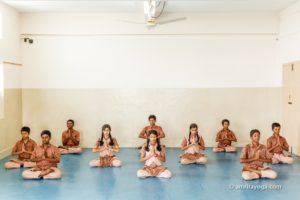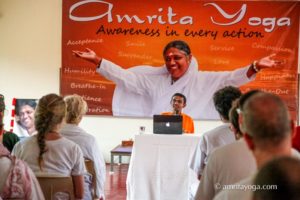 The essence of Amrita Yoga is bringing awareness to every single action. The asanas are a tool for connection with the inner self. By bringing awareness into each movement, we connect to the deeper essence within each movement. The posture is actually manifesting from an inner knowledge. A divine intelligence manifests through the posture, instead of finding or forcing or fixing the alignment of the posture from the outside.
The essence of Amrita Yoga is bringing awareness to every single action. The asanas are a tool for connection with the inner self. By bringing awareness into each movement, we connect to the deeper essence within each movement. The posture is actually manifesting from an inner knowledge. A divine intelligence manifests through the posture, instead of finding or forcing or fixing the alignment of the posture from the outside.
Focusing on the breath and MA OM mantras (unique tools registered with our practices), along with Amma’s sankalpa (intention) are the foundation. These help the body and mind with the breath as a bridge, to unfold from a deeper place without any force.  When practice unfolds from this place, there is nowhere to go. The posture blossoms naturally in its own time like a flower. It’s a spontaneous movement because the knowledge of the posture unfolds in each body from deep within. Thus, asanas are a tool to connect to the divinity, to the truth.
When practice unfolds from this place, there is nowhere to go. The posture blossoms naturally in its own time like a flower. It’s a spontaneous movement because the knowledge of the posture unfolds in each body from deep within. Thus, asanas are a tool to connect to the divinity, to the truth.
How to make a daily Amrita Yoga practice?
A daily yoga practice is important. When you take this step, a deepening of your sadhana (spiritual practice) and your connection with the Divine unfolds. A daily practice matures a student’s understanding and relationship with their innate Self.
Joining a yoga class or a retreat, listening from within and following the teacher’s instructions is the first step. After training for some time with a qualified teacher the time is ripe for a daily yoga practice at home.
 As a beginner, learning yoga from a youtube video might not be the best. It may be difficult because there is no access to the physical presence or guidance of an experienced person. Also one may often require variations and adopt the practices to suit their body type.
As a beginner, learning yoga from a youtube video might not be the best. It may be difficult because there is no access to the physical presence or guidance of an experienced person. Also one may often require variations and adopt the practices to suit their body type.
Also practicing yoga without the right understanding and awareness can create obstacles in the short or long term. After you feel confident enough and receive a teacher’s guidance you can start building your daily practice.
 Start with a sequence that is comfortable and safe for you, with some understanding of all the asanas in that sequence. It is good if some of the asanas are challenging with effort made while practicing. Don’t worry if you cannot perform an asana in its entirety. Striving toward the goal is an essential part of yoga. Remember the true goal of yoga is to go beyond the asana in its physical sense. True asana is the seat of consciousness. Abiding in this seat is the most important.
Start with a sequence that is comfortable and safe for you, with some understanding of all the asanas in that sequence. It is good if some of the asanas are challenging with effort made while practicing. Don’t worry if you cannot perform an asana in its entirety. Striving toward the goal is an essential part of yoga. Remember the true goal of yoga is to go beyond the asana in its physical sense. True asana is the seat of consciousness. Abiding in this seat is the most important.
In daily practice, there are different types of asanas: Warming up, Seated, On knees, Standing and Balancing, Prone and Back bending, Twists, Supine and Restorative.
Surya Namasakarah is usually practiced during the second quarter of a four part sequence. We suggest 2 rounds of Surya Namaskarah practice.
As human beings we have like and dislikes. These will also arise in our daily yoga practice. Watch your mind all the time, especially while practicing asanas. The mind might go towards certain asanas where we have more preferences and less towards certain other asanas. Try to stay balanced with likes and dislikes. Such training rejuvenates the body and cultivates a relaxed, centered mind.
 What about boredom in an on-going practice?
What about boredom in an on-going practice?
Five out of seven days weekly do the same sequence while incorporating small changes from day to day. For the other two days add different asanas that are usually not done. Try some variations. Explore new materials according to your teacher’s suggestions. This really helps to maintain your enthusiasm and creativity.
If your mind says its bored then you can always look for some changes. Remember that there is nothing wrong with feeling bored. Be aware. Watch the thoughts, feelings and sensations that are associated with it. With a constant focus on balancing the practice, you will find that these thoughts and sensations subside taking you to a state of silence and stillness, our true nature.
What if I have only 20 minutes to practice?
Time put into spiritual practice is never wasted. Even if you have only 20 minutes, it is still worthwhile. It is better to start with a practice that is shorter and feasible than to start with a 90 minutes daily. Being realistic is very important. Regular practice is more important than setting an unrealistic goal and stopping practice. On weekends when there is more time available, stretch the practice beyond 20 minutes.
Basic structure for a holistic yoga practice:
- Opening Prayer
- Warm up postures
- Surya Namaskarah – 2 rounds
- Standing, Balancing postures
- Seated Twists
- Back Bends
- Supine Cooling Down
- Relaxation
- Closing Prayer
We hope these guidelines help you enjoy your daily yoga practice!
Authors: Punita-Shirley Abrahamer and Siddharth-Maoz Loants with Brahmacharini Shobhana
As always, thoughtful comments are invited and appreciated. Share your reflections with us! See below to leave a comment.

0 Comments